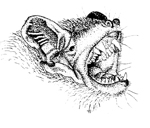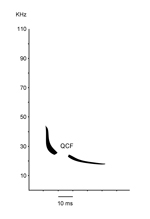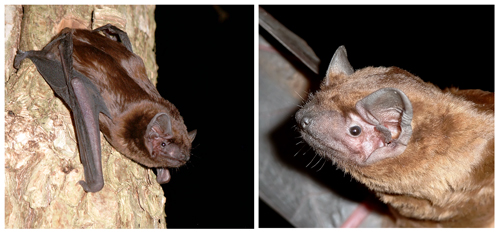Európa egyik legnagyobb denevérfaja, a Nyctalus génusz három európai fajának legnagyobb képviselője. A hát rozsdásbarna, vöröses, a hasi oldal világosabb. Orra széles, oldalról enyhén lapított. Fülei szélesek, háromszög alakúak, végük lekerekített. A fülfedő gomba alakú. Szárnyai hosszúak, a végükön keskenyek.
Hálózáskor fogott rőt koraidenevér egyed.
A Földközi tenger szigeteit, félszigeteinek déli részét illetve a Skandináv félsziget északi részét kivéve egész Európában elterjedt. Az egyik leggyakoribb denevér faj. Romániában számos nagy egyedszámú kolóniája ismert.
Szülőkolóniáit megtalálhatóak úgy faodvakban, mint épületek repedéseiben. Hibernálhat a már említett faodvakban, de számos nagy egyedszámú kolóniája ismert barlangokból is. Magasan a talaj fölött (kb. 10-50 m) vadászik, röpte egyenes vonalú és gyors. Táplálékát nagytestű rovarok, pillangók teszik ki. Hosszútávon vándorló faj (átlagosan 1000 km alatt), a legnagyobb megtett táv 1546 km. Átlagéletkora 2.2 év, a legmagasabb feljegyzett életkor 12 év.
Gyakorisága miatt nehezen megállapítható egy populációs trend. Potenciális veszélyeztető tényezők a természetes élőhelyek csökkenése, valamint a vándorlás szempontjából akadályt képező egyre gyakoribb szélmalmok.
Baltag E., Pocora I., Pocora V. (2009): Chiropterofauna din aria Cheile Bicazului, Cheile Şugăului, Peştera Toşorog (A Békási-szoros, Súgó-szoros és Toşorog barlang denevérfaunája). Migrans, XI(1): 2-4.[PDF]
Barbu P., Şin Gh. (1968): Observaţii asupra hibernării speciei Nyctalus noctula (Schreber, 1774) în faleza Lacului Doloşman-Dobrogea. Studii şi Cercetări de Biologie, ser. Zoologie, Bucureşti, 20(3): 291-297.[PDF]
Barti L. (1997): Denevérszámlálási adatok a Crysis Barlangkutató Klub adatbázisából (1996-1997). Erdélyi Gyopár, 7(5): 28.[PDF]
Barti L. (1998): Liliecii. Rezultatele activităţii de numărătoarea şi determinarea liliecilor, desfăşurate sub egida Clubului de Speologie Crysis în perioada 1996 Oct. 1997 Iun. Speomond, 3: 32.[PDF]
Barti L., Kovács I. (2001): A málnásfürdői mofetták gerinces áldozatainak jegyzéke (1999 febr. 28. - 2000 szept. 18). Acta Siculica, 1: 103-112.
Barti L. (2002c): A szászrégeni Kohl István-gyűjteményben talált denevérpreparátumok jegyzéke. Acta Siculica, Acta Hargitensia VIII, 2: 139-143.
Barti L. (2002d): A Daday Jenő által létrehozott denevérgyűjtemény a kolozsvári Állattani Múzeumban. Múzeumi Füzetek, 11: 67-72.[PDF]
Barti L., Dóczy A., Jére Cs., Varga Á. (2006): Rezultatele recensământului de lilieci în locurile de hibernare subterane în Sud-estul Transilvaniei. First Conference on Bat Conservation in Romania, Book of abstracts, Ed. Romanian Bat Protection Association, p.13.[PDF]
Barti L., Dóczy A., Jére Cs., Varga Á. (2007): Denevér-telelőhely ellenőrzések eredményei Délkelet-Erdélyben. Proceedings of the 5th Conference of the Bat Conservation in Hungary (Pécs, 3th to 4th of December 2005) and 6th Conference of the Bat Conservation in Hungary (Mártély, 12th to 14th of October 2007), Magyar Denevérkutatók Baráti Köre, Budapest, p. 51-62.[PDF]
Barti L., Jére Cs., Dóczy A., Szodoray-Parádi F. (2007): A Vargyas-szoros recens és szubfosszilis denevérfaunája és faunisztikai adatbázisa a kezdetektől 2007 februárjáig. Acta Siculica, p. 153-178.[PDF]
Bazilescu E. (1983): Consideraţii asupra faunei de mamifere din Oltenia şi propuneri pentru ocrotirea speciilor rare. Studii şi Cercetări, Drobeta Turnu-Severin, p. 195-199.[PDF]
Bielz E.A. (1856): Fauna der Wirbelthiere Siebenbürgens, eine systematische Aufzählung und Beschreibung der in Siebenbürgen vorkommenden Säugethiere, Vögel, Amphibien und Fische. Verein für siebenbürgische Landeskunde, Sibiu, p. 3-6.[PDF]
Bielz E.A. (1886): Über die in Siebenbürgen vorkommenden Fledermäuse. Verhandlung und Mittheilungen des siebenbürgischen Vereins für Naturwissenschaften, Sibiu, 36: 76-84.[PDF]
Bielz E.A. (1888): Die Fauna der Wirbeltiere Siebenbürgens nach ihren gegenwärtigen und jetzigen Bestande. Verhandlung und Mittheilungen des siebenbürgischen Vereins für Naturwissenschaften, Sibiu, 38: 15-36.[PDF]
Borda D. (2002): The distribution of bats in Romanian caves (I). Travaux de l'Institut de Spéologie "Émile Racovitza" , Bucureşti, XXXVII - XXXVIII (1998-1999): 223-230.[PDF]
Borda D. (2002): Chiropterele. in: Racoviţă Gh., Moldovan O., Onac B. (ed.): Monografia carstului din Muntii Padurea Craiului, Studiu monografic. Presa Universitară, Cluj-Napoca, p. 172-182.[PDF]
Chiş T., Manole M.G. (2004): The presence of Myotis mystacinus (Kuhl, 1818), Nyctalus noctula (Schreber, 1774) and Barbastella barbastella (Schreber, 1774) species (Chiroptera: Vespertilionidae) in the Maramureş Depresion (Romania). Travaux du Museum Naţional d'Historie Naturelle "Grigore Antipa", XLVII: 311-314.[PDF]
Coroiu I., Viehmann I., David A. (2006): Dinamica multianuală a liliecilor în Peştera Huda lui Papară în perioada de iarnă. First Conference on Bat Conservation in Romania, Book of Abstracts, Ed. Romanian Bat Protection Association, p. 4.[PDF]
Coroiu I., David A. (2008): Long-term changes of hibernating bats in Huda lui Papară Cave (Apuseni Mountains, Romania). Abstract. XIth European Bat Research Symposium, 18-22 August, 2008, Cluj-Napoca, Romania, p. 39.[PDF]
Daday J. (1885a): Előleges jelentés az erdélyi múzeum egylet igazgatóválasztmányának megbízásából az 1884-ik év nyarán tett chiropterológiai gyűjtések eredményéről. Orvos-Természettudományi Ėrtesitő, Kolozsvár, X(3), VII(1): 60-64.[PDF]
Daday J. (1885b): Jelentés az Erdélyi Országos Muzeum-Egylet igazgató-választmányának megbízásából az 1885-ik év nyarán végzett chiropterologiai gyűjtések eredményéről és az Erdélyi Múzeum-Egylet denevérgyűjteményének jegyzéke. Orvos-Természettudományi Értesítő, Kolozsvár, X(3), VII(3): 266-276.[PDF]
Daday J. (1887): Új adatok Erdély denevérfaunájának ismeretéhez. Magyar Tudományos Akadémia, Értekezések a Természettudományok köréből, Budapest, XVI(7): 1-47.[PDF]
Dobrosi D., Gulyás J. (1997): A bihari barlangok denevérei. Proceedings of the 1st Conference on Bat Conservation in Hungary, Magyar Denevérkutatók Baráti Köre, Budapest, p. 34-36.[PDF]
Dumitrescu M., Orghidan T., Tanasachi J. (1955): Două descoperiri interesante în Peştera Cioclovina cu Apă. Buletin Ştiinţific, Academia R.P.R., Secţia de Sţiinţe Biologice, Agronomice, Geologice şi Geografice, Bucureşti, VII(2): 360-368.
Dumitrescu M. (1959): Săpăturile de la Peştera (com. Măgura, rai. Codlea). Materiale şi Cercetări Arheologice, 6: 25-31.[PDF]
Dumitrescu M., Tanasachi J., Orghidan T. (1962-1963b): Răspândirea chiropterelor în R.P. Română. Travaux de l'Institut de Spéologie "Émile Racovitza", Bucureşti, XXXIV: 509-575.[PDF]
Dumitrescu M., Orghidan N., Orghidan T., Puşcariu V., Tanasachi J., Georgescu M., Avram Şt. (1967): Contribuţii la studiul peşterilor din regiunea Hunedoara. Lucrările Institutului de Speologie "Emil Racoviţă", Bucureşti, VI: 9-88.[PDF]
Ifrim I., Pocora V. (2006): Aspecte preliminare privind studiul chiropterelor din Pădurea Letea. First Conference on Bat Conservation in Romania. Book of Abstracts, Ed. Romanian Bat Protection Association, p. 6.[PDF]
Ifrim I., Pocora V. (2007b): Preliminary aspects about the study of bats from Letea Forest - Danube Delta. Scientific Annals of the Danube Delta Institute, 13: 27-34.[PDF]
Jére Cs., Dóczy A. (2005): Data on the bat fauna of the upper part of the Târnava rivers basin (Transylvania, Romania). in Curtean-Bănăduc Angela, Bănăduc D. & Sîrbu I. (ed.): Transylvanian Review of Systematical and Ecological Research, 2. The Târnava River Basin, Sibiu, p. 167-172.[PDF]
Jére Cs., Dóczy A., Barti L. (2007): Results of research on the bat fauna of the Vârghiş Gorge (Eastern Carpathians, Romania). Travaux de l'Institut de Spéologie "Émile Racovitza", XLV-XLVI, p. 59-74. [PDF]
Lup L. (2004): Data regarding the bat communities (Mammalia: Chiroptera) from abandoned mine roosts in Sibiu County. Acta oecologica, Studies and ecology research XI(1-2): 217-222.[PDF]
Matschie P. (1901): Über rumänische Säugethiere. Sitzungs-Berichte der Gesellschaft Naturforschender Freunde, Berlin, 9: 220-238.[PDF]
Murariu D. (2002): Contributions to the knowledge of mammal fauna (Mammalia) from south west Romania. Travaux du Muséum National d'Histoire Naturelle "Grigore Antipa", XLIV: 431-441.[PDF]
Murariu D., Decou V., Gheorghiu V. (2004): Bat specific structure over the year in the Gura Ponicovei Cave from South-Western Carpathians (Romania). Travaux du Museum National d'Histoire Naturelle "Grigore Antipa", XLVII: 315-323.[PDF]
Murariu D. (2006): Mammal ecology and distribution from North Dobrogea (Romania). Travaux du Museum National d'Histoire Naturelle "Grigore Antipa", XLIX: 49: 387-399.[PDF]
Murariu D., Chişamera G. (2006): Partial albinism in noctule bat, Nyctalus noctula (Schreber, 1774) (Mammalia: Chiroptera) from Romania. Travaux du Museum National d'Histoire Naturelle "Grigore Antipa", XLIX: 353 - 357.[PDF]
Nagy L.Z, Szántó L. (2003): The occurence of hibernating Pipistrellus pipistrellus (Schreber, 1774) in caves of the Carpathian Basin. Acta Chiropterologica, 5(1): 155-160.[PDF]
Nagy L.Z., Barti L., Dóczy A., Jére Cs., Postawa T., Szántó L., Szodoray-Parádi A., Szodoray-Parádi F. (2005): Survey of Romania's underground bat habitats Carpathian's underground bat habitats. Status and distribution of cave dwelling bats (2002-2004). Final report for the BP Conservation Programme. Survey of Southern and Western Carpathians underground bat habitats & Survey of Eastern Carpathians and Dobrogea underground bat habitats, Ed. Lizard, Cluj, pp. 44.[PDF]
Negrea A., Botoșăneanu L., Negrea Şt. (1967): Documents pour servir à la connaissance de la faune de mammifères des grottes du Banat (Roumanie). International Journal of Speleology, 2(4): 341-353.[PDF]
Orghidan T., Dumitrescu M. (1962-1963): Studiu monografic al complexului carstic din defileul Vîrghisului. Lucrările Institutului de Speologie "Emil Racoviţă", I-II: 69-179. [PDF]
Oros I., Pora E.A. (1960): Absorbţia şi distribuţia P32O4H2Na la liliac (Nyctalus noctula) în perioada de hibernaţie. Studia Universitatis Babeş-Bolyai, Cluj, ser. Biologia, II(2): 267-273.[PDF]
Papuc I., Miclăuş V., Lisovschi-Cheleşeanu C., Paşca C., Gudea A., Mireşan V. (2000): Particularităţi anatomice ale cavităţii bucale la liliac (Nyctalus noctula). Rev. Rom. Med. Vet., 10(2): 171-175.
Pora E.A., Roşca D.I. (1955): Variaţia hidremiei, grăsimilor şi hematiilor la liliac (Nyctalus noctula) in timpul hibernaţiei. Comunicările Academiei R.P.R., Bucureşti, V(8): 1165-1170. [PDF]
Sike T., Szodoray-Parádi F., Krecsák L. (2001): Adatok Szatmár megye kisemlős faunájához. Múzeumi Füzetek, Kolozsvár, 10: 142-148.[PDF]
Szodoray-Parádi F., Szodoray-Parádi A., Sike T. (2005): Building dwelling bats survey in Satu Mare County, Romania. Studii şi comunicări, ser. Știinţele naturale, Muzeul Judeţean Satu Mare, IV-V: 196-200.[PDF]
Szodoray-Parádi F., Szodoray-Parádi A. (2005): Results on the investigatin on bats fauna in Vânători Neamţ Natural Park and conservation status of the occurring bat species. Studies and research in Vânători Neamţ Natural Park, I: 93-98.[PDF]
Topál Gy. (1954): A Kárpát-medence denevéreinek elterjedési adatai. A Magyar Nemzeti Múzeum Természettudományi Osztályának Évkönyve, Budapest, 46: 471-483.[PDF]
Valenciuc N., Ion I. (1969b): Date noi privind răspîndirea chiropterelor din România. Analele Ştiinţifice ale Universităţii "Al. I. Cuza", Iaşi, sec. Ştiinţe naturale, a. Biologie, XV(1): 135-138.[PDF]
Valenciuc N., Ion I. (1970): Studiul craniometric al cîtorva specii de chiroptere din România. Comunicări de Zoologie, p. 231-241.[PDF]
Valenciuc N. (1972b): Importanţa corelaţiilor statistice în reconstituirea şi determinarea craniilor aparţinând unor specii de chiroptere din România. Studii şi Comunicări, Botoşani, Muzeul de Ştiinţele Naturii Dorohoi, p. 211-217.[PDF]
- Bogdanowicz W. (1999): Nyctalus noctula. In: A.J. Mitchell-Jones, G. Amori, W. Bogdanowicz, B. Kryštufek, P.J.H. Reijnders, F. Spitzenberger, M. Stubbe, J.B.M. Thissen, V. Vohralík, and J. Zima (eds): The Atlas of European Mammals. Academic Press, London.
- Dietz C., Helversen O., Nill D. (2007): Nyctalus noctula. Handbuch der Fledermäuse Europas und Nordwestafrikas. Kosmos Verlag, Stuttgart. Pp. 267-272.
- Petit E., Mayer F. (1999): Male dispersal in the noctule bat (Nyctalus noctula): where are the limits? Proc. Roy. Soc. Lond. B. 266: 1717-1722.















